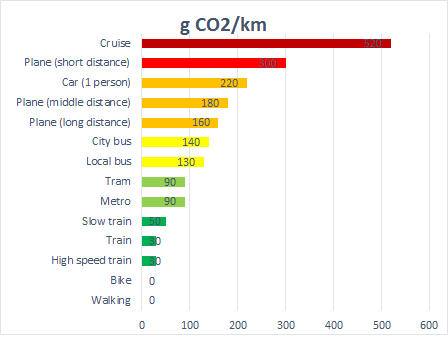
Measured in grams of CO2 emissions per passenger-kilometer. We have considered the average capacity of each vehicle as well as the effects that each one has on the climate.
Each form of transportation emits CO2; but there are large differences between them. On the left you see a brief overview of the different modes of transport based on average numbers. These numbers can very depending on the occupancy rate and the way the petrol or electricity was generated, but give a global indication of the pollution per km.
The ingredients of air pollution
Cars and trucks produce air pollution throughout their life, including pollution emitted during vehicle operation, refueling, manufacturing, and disposal. Additional emissions are associated with the refining and distribution of vehicle fuel.
Air pollution from cars and trucks is split into primary and secondary pollution. Primary pollution is emitted directly into the atmosphere; secondary pollution results from chemical reactions between pollutants in the atmosphere. The following are the major pollutants from motor vehicles:
- Particulate matter (PM). These particles of soot and metals give smog its murky color. Fine particles — less than one-tenth the diameter of a human hair — pose the most serious threat to human health, as they can penetrate deep into lungs. PM is a direct (primary) pollution and a secondary pollution from hydrocarbons, nitrogen oxides, and sulfer dioxides. Diesel exhaust is a major contributor to PM pollution.
- Hydrocarbons (HC). These pollutants react with nitrogen oxides in the presence of sunlight to form ground level ozone, a primary ingredient in smog. Though beneficial in the upper atmosphere, at the ground level this gas irritates the respiratory system, causing coughing, choking, and reduced lung capacity.
- Nitrogen oxides (NOx). These pollutants cause lung irritation and weaken the body’s defenses against respiratory infections such as pneumonia and influenza. In addition, they assist in the formation of ground level ozone and particulate matter.
- Carbon monoxide (CO). This odorless, colorless, and poisonous gas is formed by the combustion of fossil fuels such as gasoline and is emitted primarily from cars and trucks. When inhaled, CO blocks oxygen from the brain, heart, and other vital organs. Fetuses, newborn children, and people with chronic illnesses are especially susceptible to the effects of CO.
- Sulfur dioxide (SO2). Power plants and motor vehicles create this pollutant by burning sulfur-containing fuels, especially diesel. Sulfur dioxide can react in the atmosphere to form fine particles and poses the largest health risk to young children and asthmatics.
- Hazardous air pollutants (toxics). These chemical compounds have been linked to birth defects, cancer, and other serious illnesses. The Environmental Protection Agency estimates that the air toxics emitted from cars and trucks — which include Benzene, acetaldehyde, and 1,3-butadiene — account for half of all cancers caused by air pollution.
- Greenhouse gases. Motor vehicles also emit pollutants, such as carbon dioxide, that contribute to global climate change. In fact, cars and trucks account for over one-fifth of the United States’ total global warming pollution; transportation, which includes freight, trains, and airplanes, accounts for around thirty percent of all heat-trapping gas emissions.
Source: http://www.ucsusa.org/
